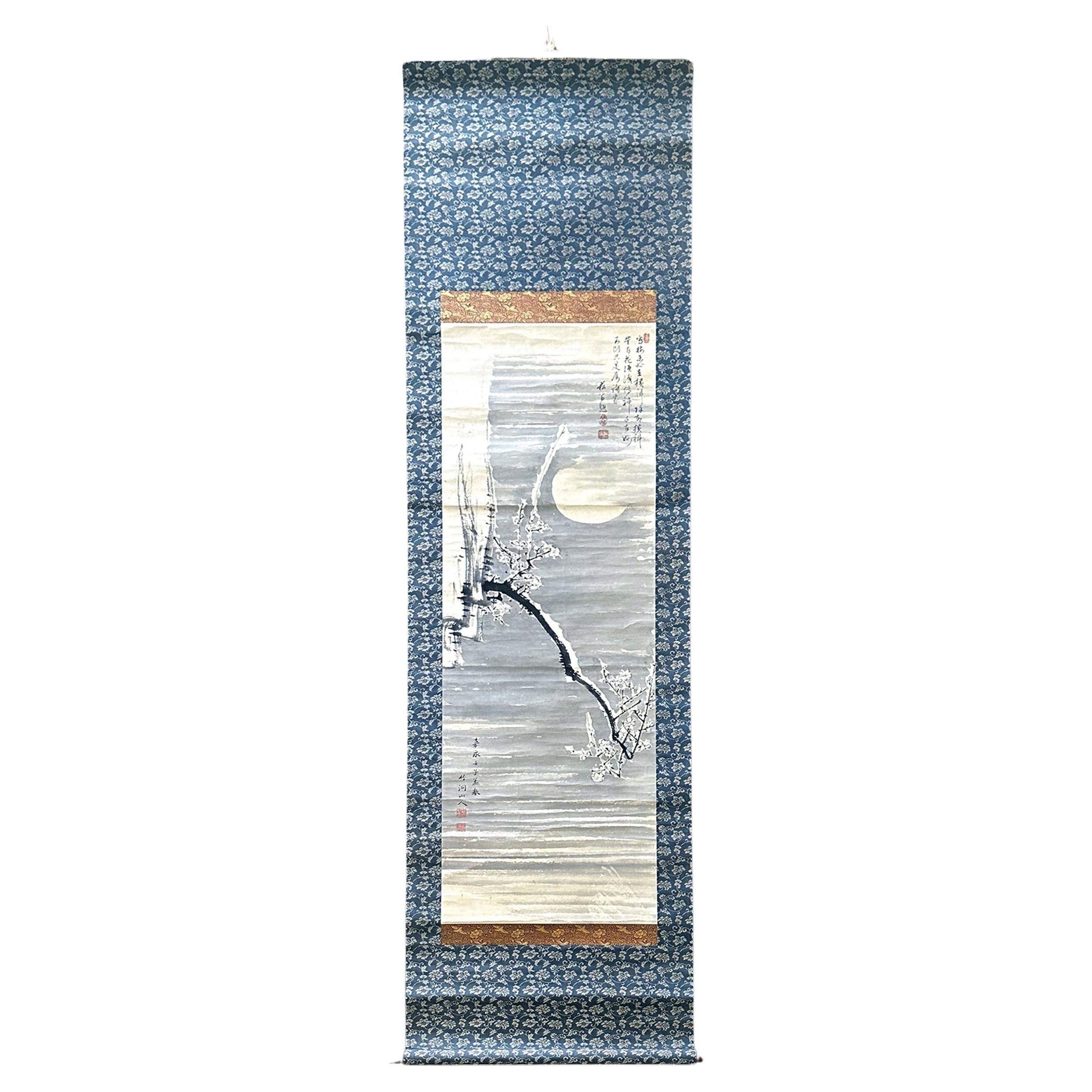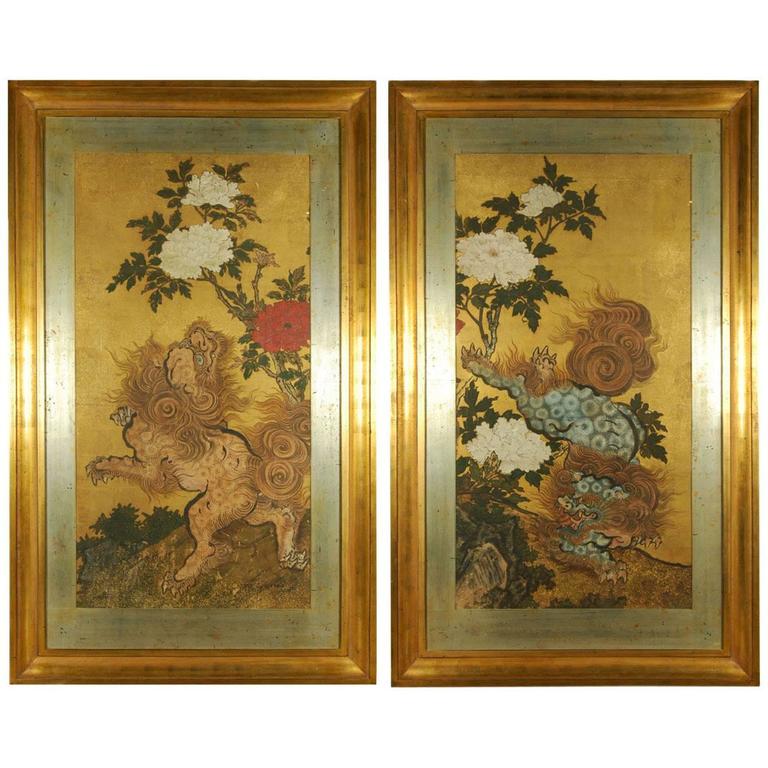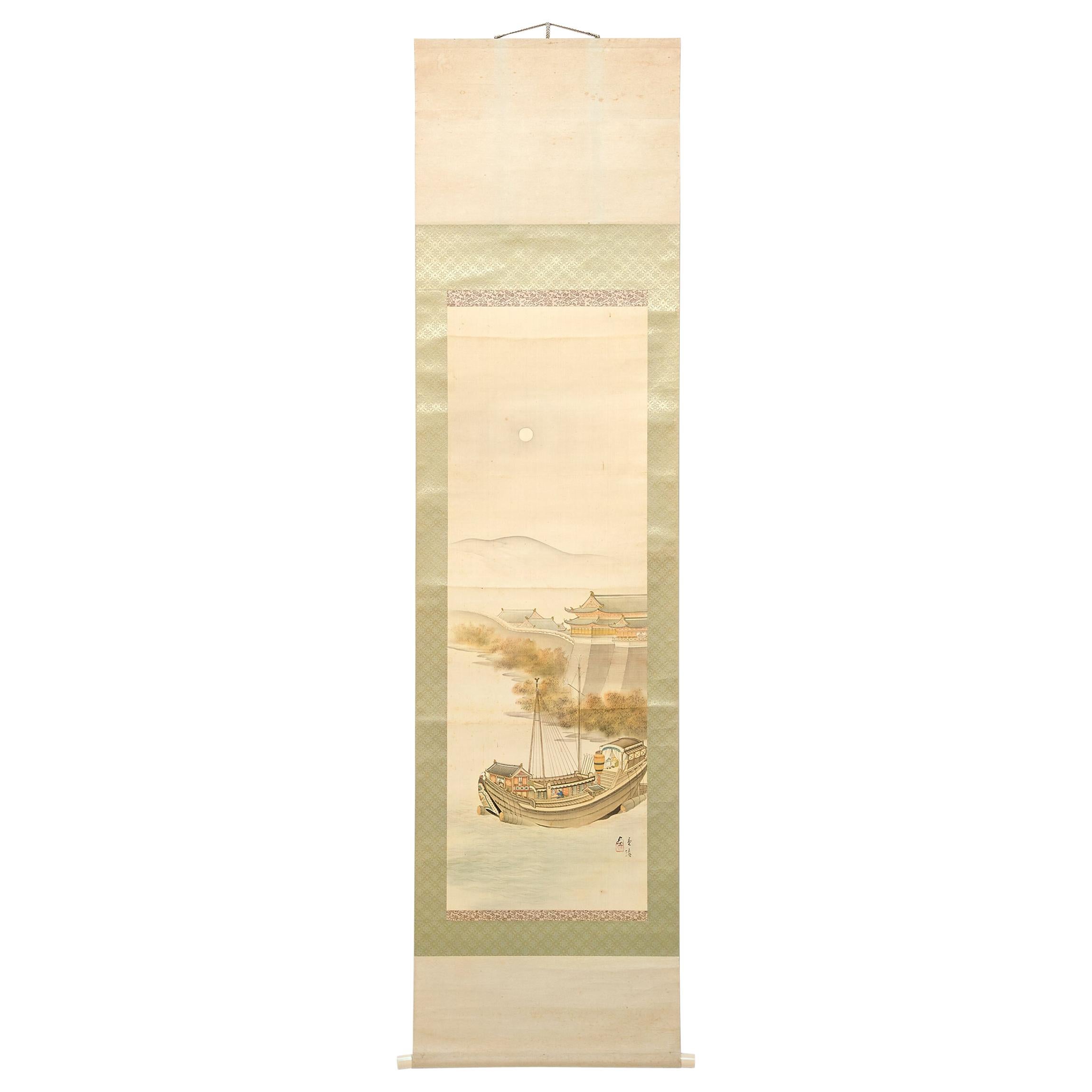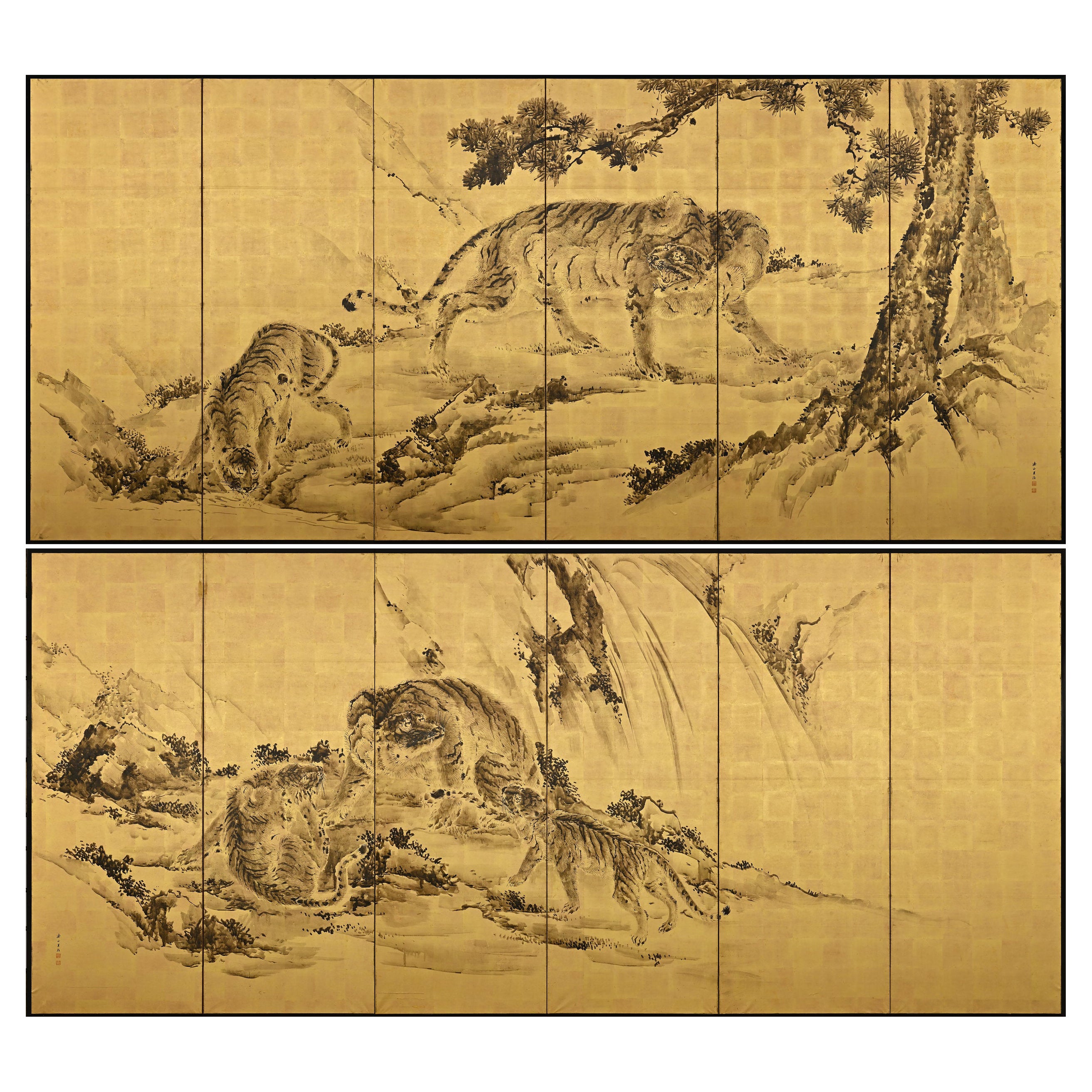Items Similar to Antique hanging scroll of Japanese cat/Late Edo-Meiji period/Cat painting
Want more images or videos?
Request additional images or videos from the seller
1 of 17
Antique hanging scroll of Japanese cat/Late Edo-Meiji period/Cat painting
About the Item
This is a picture of a cat drawn by a person named "Toshizumi Nitta" from the end of the Edo period to the beginning of the Meiji period.
She is a very simple and cute cat.
He is a vassal of the Tokugawa Shogunate, born in Ota City, Gunma Prefecture (southern part of Gunma Prefecture).
He was related to the Tokugawa family and lived in a large mansion in the Ota clan in Gunma prefecture.
However, the Nitta family's territory was very small, and they were by no means a wealthy vassal.
He seems to have lived quite poorly.
So he painted cats and sold them to people.
The Nitta family continued to draw pictures of this cat for four generations.
"Nitta toshizumi" is equivalent to the fourth generation.
During the Edo period, sericulture was thriving in the Kanto region.
Cats were said to be the gods of silkworms, as they drive away mice, the natural enemies of silkworms.
It was the Nitta family who drew such a cat on paper, pasted it in the silkworm chamber, and sold it as a mouse repellent.
There were also other monks who painted pictures of cats, but the Nitta family in particular was related to the Tokugawa family, so people believed that paintings of cats had special powers. , a lot of paintings were sold.
Even today, the paintings of cats drawn by the Nitta family (from the late Edo period to the early Meiji period) are very popular and highly regarded in Japan.
This time I was able to obtain this painting from a collector using a special route.
I think this plump cat with soft brushstrokes is a very nice painting.
I think this is a special painting that is different from ordinary paintings.
In the past, an art museum in Gunma Prefecture held an exhibition of cat paintings drawn by the Nitta family. I have attached the photo.
The part circled in red is the era in which "Nitta toshizumi" lived.
Please handle with care as it is a very old hanging scroll.
A dedicated storage box is included.
Weight: 0.2kg
size
width
Including the tip of the hanging scroll tree: 47.5 cm
Width of paper only: 41.5 cm
Total length (paper part only): 106.5 cm
- Dimensions:Height: 41.93 in (106.5 cm)Width: 18.71 in (47.5 cm)Depth: 0.08 in (2 mm)
- Style:Edo (Of the Period)
- Materials and Techniques:
- Place of Origin:
- Period:
- Date of Manufacture:1855-1880
- Condition:
- Seller Location:Sammu-shi, JP
- Reference Number:1stDibs: LU5487232182592
About the Seller
5.0
Platinum Seller
These expertly vetted sellers are 1stDibs' most experienced sellers and are rated highest by our customers.
Established in 2015
1stDibs seller since 2020
1,105 sales on 1stDibs
Typical response time: 4 hours
- ShippingRetrieving quote...Ships From: senzoku, Japan
- Return PolicyA return for this item may be initiated within 7 days of delivery.
More From This SellerView All
- Japanese Antique Ink Painting / 19th Century / Rare Chinese Character PaintingLocated in Sammu-shi, ChibaWe have a unique Japanese aesthetic sense. And only we can introduce unique items through our purchasing channels in Japan and the experience we have gained so far, in such a way that no one else can imitate. It is an ink painting written after the Meiji era. The biggest attraction of this work is that it uses Chinese characters to create paintings. To explain in detail, it is written here in Chinese characters as "un-ryu" . "Un" is a cloud and "ryu" is a dragon. These are embodied and drawn by comparing them to the meaning of Chinese characters. And the clouds depict the clouds hanging over the mountain, and the dragon depicts the climbing toward the mountain. Humorous paintings...Category
Antique Late 19th Century Japanese Edo Paintings
MaterialsAcrylic, Paper
- Japanese Antique "Staircase Chest" 'Late Edo Period-Meiji Period' /CabinetLocated in Sammu-shi, ChibaWe have an aesthetic sense peculiar to Japanese people. And we introduce the unique items that only we can do, the route of purchasing in Japan, the experience value so far, and the way that no one can imitate. Japanese antique black chest "staircase chest...Category
Antique 19th Century Japanese Edo Furniture
MaterialsCedar
- Japanese antique sketch scroll / 1800-1900 / Flower, bird and animal paintingsLocated in Sammu-shi, ChibaThis is a rough sketch of a Japanese painting drawn around the late Edo period to the early Meiji period (1800-1900) in Japan. A picture is drawn by sticking and connecting short pi...Category
Antique 19th Century Japanese Edo Paintings and Screens
MaterialsPaper
- Japanese Antique Wooden Drawer/Late Edo-Meiji Period/1800-1900/TV StandLocated in Sammu-shi, ChibaThis is an old Japanese wooden drawer made in the late Edo period to around the Meiji period (1800-1900). The material is made of cedar, and the unique wood grain is very beautiful....Category
Antique 19th Century Japanese Edo Commodes and Chests of Drawers
MaterialsCedar
- Japanese antique wall-hanging wooden Buddha statue/Edo period/1603-1868/WabisabiLocated in Sammu-shi, ChibaThis is a wooden Buddha statue made around the Edo period in Japan. Although it is a small Buddha statue, it has a strong presence and is beautiful. Originally, there was a wooden pe...Category
Antique 18th Century Japanese Edo Sculptures and Carvings
MaterialsCypress
- Japanese Antique Small Wooden Drawer / 1865-1868 / Late Edo Period / Storage BoxLocated in Sammu-shi, ChibaThis is a small Japanese wooden drawer. I think it's a drawer that was used in shops and other places where small tools were put. The handle is made of iron. It is a cool drawer...Category
Antique Late 19th Century Japanese Edo Commodes and Chests of Drawers
MaterialsCedar
You May Also Like
- Antique Japanese Ink Hanging Scroll Nakabayashi Chikuto Edo PeriodBy Hidaka TetsuoLocated in Atlanta, GAAn ink painting on paper (Sumi-e) mounted with brocade borders as a hanging scroll. Entitled "Plum Blossom Under a Misty Moon", the artist was Japanese painter Nakabayashi Chikuto (1...Category
Antique 19th Century Japanese Japonisme Paintings and Screens
MaterialsBrocade, Wood, Paper
- Two Antique Japanese Hanging Scroll PaintingsLocated in Atlanta, GATwo Japanese scroll painting depicts scenes from the Tale of Genji (Genji-E), from Edo period. These painting were purchased from Odewara Shoten in the...Category
Antique Early 19th Century Japanese Japonisme Paintings and Screens
MaterialsBrocade, Paper
- Japanese Silk Scroll Painting of Moneys Edo Period Mori TetsuzanLocated in Atlanta, GAA Japanese mounted vertical hanging scroll painting by Mori Tetsuzan (Japanese, 1775-1841) circa 19th century Edo period. The watercolor and ink on silk ...Category
Antique 19th Century Japanese Japonisme Paintings and Screens
MaterialsSilk, Paper
- Pair of Antique Japanese Paintings of Karashishi, Edo Period, 18th CenturyLocated in Prahran, VictoriaA rare pair of antique Japanese Karashishi paintings in a landscape of rocks and peony flowers on gold leaf ground in fine handmade frames, Edo period, early 18th century. The Karash...Category
Antique Early 18th Century Japanese Edo Paintings and Screens
MaterialsGold Leaf
- Japanese Meiji Riverside Scroll Painting, c. 1900Located in Chicago, ILAlthough western painting was initially embraced during Japan’s Meiji period (1868-1912), artists brought on a revival of traditional painting styles as they sought to create a modern Japanese style with roots in the past. This exquisite hanging scroll demonstrates the preference for soft layering of gray tones with judicious use of color. The landscape is rendered in soft ink washes that subtly distinguish between water, mountain, and sky. The scroll painting...Category
Early 20th Century Japanese Meiji Paintings and Screens
MaterialsPaper
- Japanese Screen Pair, Tigers by Kishi Renzan, Late Edo PeriodLocated in Kyoto, JPKishi Renzan (1804-1859) Tigers Pair of six-panel Japanese screens. Ink and gold-leaf on paper. In this monochromatic pair of six-fold Japanese screens painted on gold-leaf, Kishi Renzan has created a breathtaking composition of a family of tigers. The screens are filled with a sense of drama which is conveyed by both the subject matter and the wet, expressive brushwork. The running mountain stream and the towering waterfall allude to refreshment during the summer months and we feel the tiger families familiarity and security within their environment. Renzan’s master, Kishi Ganku...Category
Antique Mid-19th Century Asian Edo Paintings and Screens
MaterialsGold Leaf
Recently Viewed
View AllMore Ways To Browse
Cat Unknown
Wall Hanging Storage
Cat Box
Drew Antique Furniture
Edo Period Japanese Painting
Antique Storage Draws
Japanese Painted Scroll
Cat Painting Antique
Antique Cat Painting
19th Century Japanese Scroll
Japanese Pictures
Red Edo
Wall Hanging Japan
Edo Period Paintings
Japanese Scrolls Painting
Large Monk
Japanese Scrolls Hand Painted
Japanese Meiji Period Box





